Daewoo DWD-MI1011 User Manual [nl]
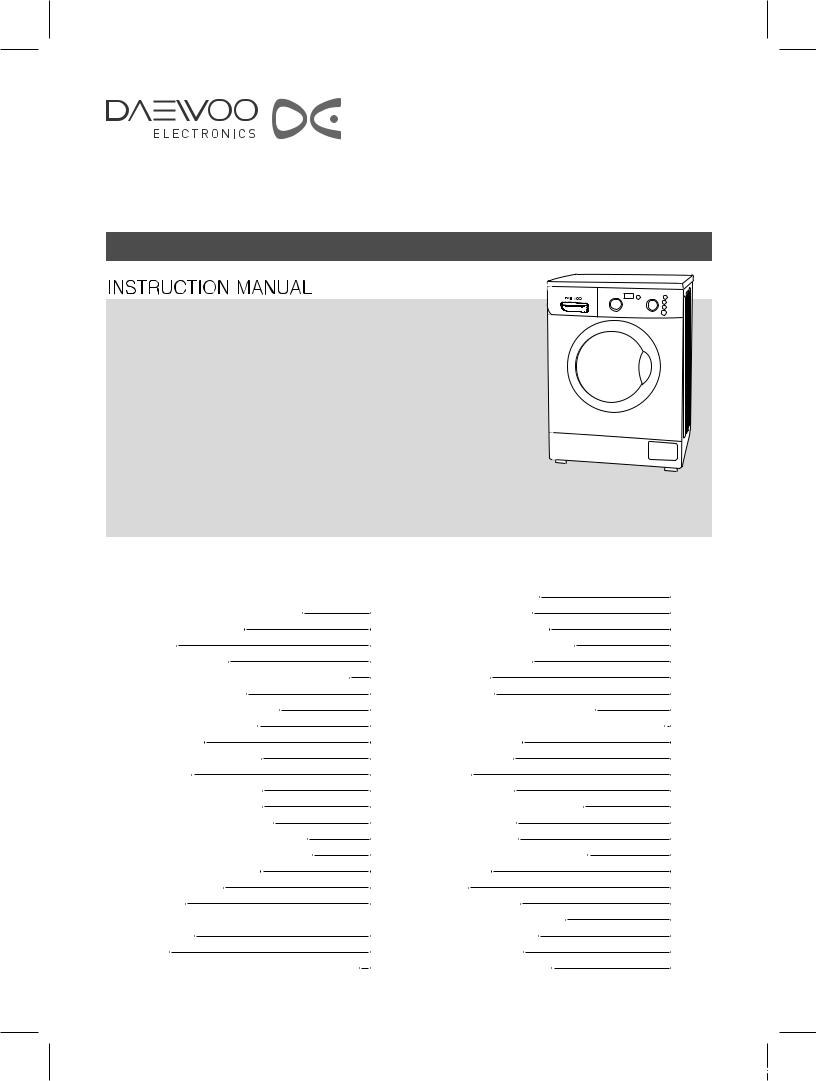
Washing Machine Instruction Manual
DWD-MI*/DWD-FI*
■ Dear Customer,
Firstly, many thanks for your preference in the purchasing of Daewoo
product. The product is made in ITALY with the nest materials, comply with RoHs and REACH regulations with a particular focus on human health and the environment.
Fundamental issues such as quality and safety are supported by strict controls on our products, which are certi ed according international standards - EN 60456:2011, EN 60335:2009, EN 62233:2010:
EN 61770:2009 and, EN ISO3741: 2010 by excellent certifying institute
VDE - IMQ.
This manual contains instructions for use, maintenance and warranty.
Before using the machine, carefully read this manual. It contains important instructions for safety, use and maintenance of the washing machine. In this way self injury and damage to the machine is avoided.
CONTENTS |
|
|
Page |
|
Your contribution to environmental protection |
3 |
Eco-design reference |
15 |
|
Safety instructions and warnings |
4 |
Fabric care symbols |
15 |
|
Description of machine |
6 |
Precautions and advice |
16 |
|
Installation |
7 |
Washing recommendations |
16 |
|
General information |
7 |
Selection of laundry |
16 |
|
Removal of transportation locking screws |
7 |
Door gasket |
17 |
|
Positioning of washing |
7 |
Door closure |
17 |
|
Installation under a work top |
8 |
Detergent and softener dosage |
17 |
|
Water supply connection |
8 |
Liquid or powdered detergent partition plate |
17 |
|
Water drainage |
9 |
Detergent powder |
18 |
|
Power supply connection |
9 |
Liquid detergent |
18 |
|
Control panel |
11 |
Softener |
19 |
|
Description of commands |
11 |
Detergent doses |
19 |
|
Programme selection dial |
11 |
Starting washing programme |
19 |
|
Temperature regulating dial |
11 |
Starting washing |
19 |
|
Spin reduction DWD-MI*/DWD-FI* |
11 |
Pausing washing |
19 |
|
Spin regulation DWD-MI*/DWD-FI* |
11 |
Loading laundry into the drum |
19 |
|
Extra rinse and rinse hold |
11 |
Maintenance |
20 |
|
Pre-wash and soak |
12 |
Cabinet |
20 |
|
Start/pause |
12 |
Detergent drawer |
20 |
|
Delayed start and child safety DWD-MI*/DWD-FI* model |
12 |
Cleaning drain pump lter |
20 |
|
Door lock led |
12 |
Emptying procedure |
20 |
|
First use |
12 |
Possible remedies |
22 |
|
Washing programmes duration and options |
13 |
Spare parts and service |
24 |
|
|
|
|
|
|
DWD-M_DWD-FI.indd 1 |
2015-05-27 10:39:06 |

DWD-M_DWD-FI.indd 2 |
2015-05-27 10:39:06 |
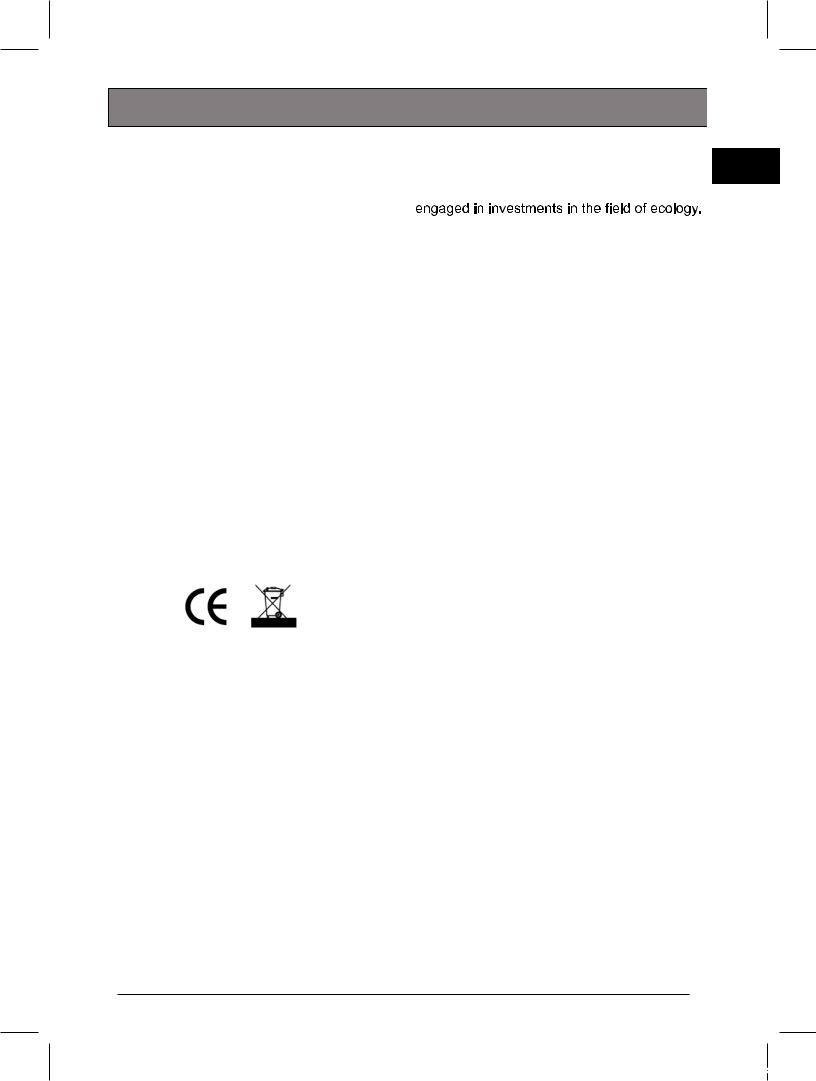
YOUR CONTRIBUTION TO ENVIRONMENTAL PROTECTION
DISPOSAL OF PACKAGING
The packaging has the purpose to protect appliance from damage that might occur during the transportation. The materials used for packaging are recyclable, so selected on the basis of respect for the environment and ease of disposal with aim of material reintegration to the production cycles. This mechanism allows on one hand to reduce the volume of waste, while the other it makes possible for a more rational usage of nonrenewable resources.
Disposal of waste electrical and electronic equipment (WEEE)
In pursuant to the legislative Decree of July 25, 2005, No. 151 in implementation of Directives 2002/95/EC, 2002/96/EC and 2003/108/EC on the disposal of electrical and electronic waste: the crossed waste bin symbol indicates that the at end of the product life span, it must be disposed separately from other waste.
Users must dispose of the appliance in question at suitable recycling centres for electronic and electrical waste or take it to the dealer when buying a new equivalent appliance, on a one to one bases.
The adequate differential collection for the subsequent forwarding of recycling, treatment and environmentally compatible disposal helps to prevent negative impact on the environment and health. It promotes the recycling of materials from the appliance.
The manufacturer Ltd has always been care- EN ful to develop technologies and products which
are environmentally friendly. It is also constantly
Improper disposal of the product by the user involves the application of administrative penalties provided by law.
3
DWD-M_DWD-FI.indd 3 |
2015-05-27 10:39:07 |
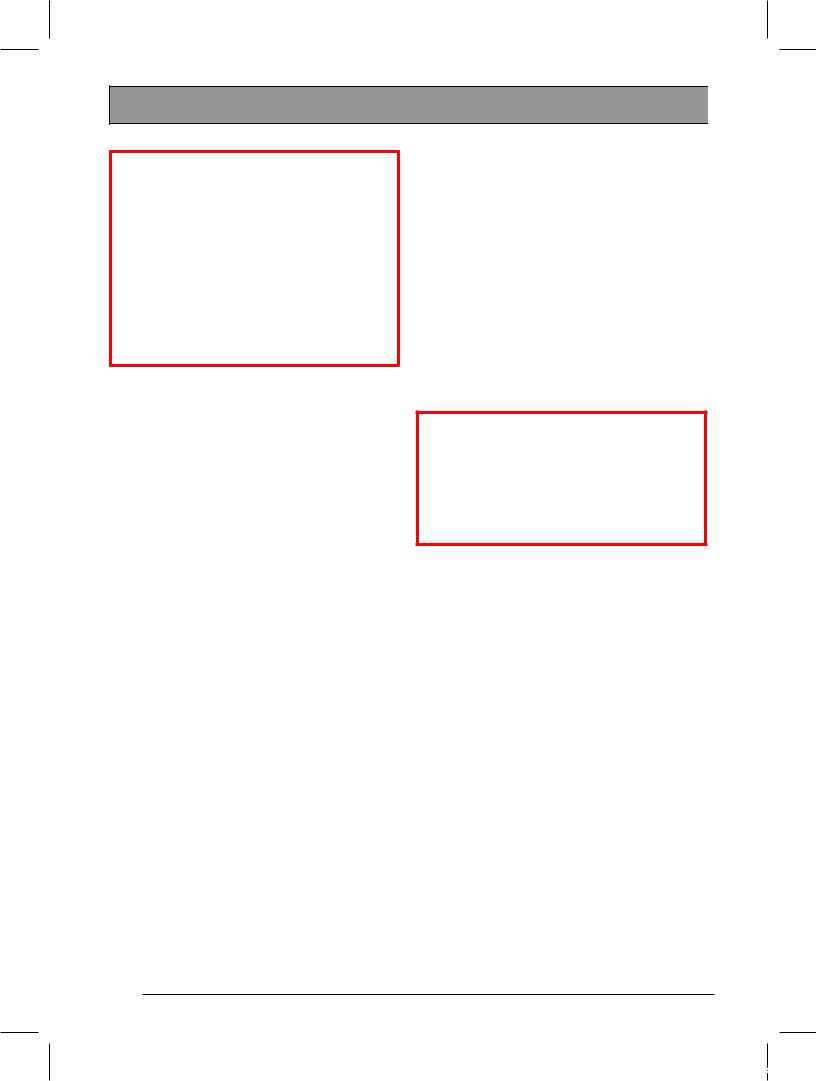
SAFETY INSTRUCTIONS AND WARNINGS
This washing machine complies with current safety standards. However, improper use can cause damage to persons and/or property.
Before using the machine for the first time, carefully read this manual. It contains important instructions for safety, usage and maintenance of the washing machine. In this way self injury and damage to the machine is avoided.
Keep the instruction manual and also pass it onto any other users.
INTENDED USE
Use the washing machine only for domestic purpose and only for washing clothes which the producer claimed on the label suitable for washing in water. Any other usage may be dangerous. The manufacturer Ltd is not liable for damage caused by misuse and/or incorrect setting of the appliance.
Those, whom for physical, sensorial or mental incapacity, and are inexperience and ignorance are not able to safely use the appliance independently can put it into operation only if supervised and taught by competent persons, who assume the responsibility.
IF THERE ARE CHILDREN
Check the children when they are close to the washing machine. Do not allow them to play with the appliance.
If washing is done at high temperatures, keep in mind that the glass door could become very hot, so keep children away from touching it.
4
TECHNICAL SAFETY
Before connecting the appliance to the electric power line compare technical data (voltage, frequency) on the rating plate with that of the mains. If in doubt, consult a qualified electrician.
The electric safety of washing machine is guaranteed only if the machine is connected to a legal standard protective (earthing system) power unit. It is a fundamental requirement for safety. Verify this condition and if in doubt have the power system checked by a qualified electrical.
NB: The manufacturer can not be held liable for damages due to lack or interruption of the protective power unit.
For safety reasons, never use electric cord extension (because of fire danger due to overheating).
Any repair on the appliance must be made only by an authorized Technical Services Department of the manufacturer, otherwise the manufacturer is not liable for damages that may result.
Repairs not performed in perfection can also expose user to serious dangers, for which the manufacturer is not answerable.
If the power cord is damaged, it must be entirely replaced by an authorized the manufacturer personal to avoid any danger.
In case of breakdowns or cleaning of the machine, keep in mind that the machine is disconnected from the mains only if:
•The power plug is unplugged, or if
•The electric power switch of the house is off, or if
•The fuse of the electrical system is completely screwed (the electric wiring disconnected).
DWD-M_DWD-FI.indd 4 |
2015-05-27 10:39:07 |

•To connect the washing machine to the water supply using only new hoses. Do not use old water inlet hoses.
Changes to the washing machine cannot be made if not specifically authorized by the manufacturer.
CORRECT USE
Do not install the appliance in places exposed to frost. Freeze might rupture or burst. Furthermore, at temperatures below zero the electronics can not function properly.
Before switching on the washing machine for the first time, remove the safety transportation screws at the back (see installation chapter). The washing machine could be damage if it spins with the safety transportation screws in place. The cabinet or adjacent components or the machine itself could be damaged.
In the event of prolonged absence (e.g. holidays), close the water tap, remove the power plug from the socket.
Be careful not to wash, with the laundry, foreign |
|
|
bodies (e.g. nails, needles, coins, paper clips). |
|
|
These foreign bodies can damage the washing |
|
|
machine (e.g. the drum or tub) and in turn, the |
|
|
EN |
||
damaged parts can ruin laundries. |
||
|
||
Items that have been previously treated with |
|
|
|
||
solvents or products containing them must be |
|
|
well rinsed in clean water before being loaded |
|
|
into the washing machine. |
|
|
Never use in washing machine detergents that |
|
|
contain solvents (eg petrol, trichlorethylene). |
|
|
These products could damage of the compo- |
|
|
nents of the machine and generate toxic fumes. |
|
Danger of explosion and fire
Never use in washing machine detergents that contain solvents (e.g. petrol, trichlorethylene). They can damage the plastic surfaces.
N.B.
The manufacturer can not be held liable for damages resulting from failure to follow these instructions.
Flood hazard
Before hanging the drain hose onto a sink, make sure that water can drain quickly. Secure the drain hose so that it can not move because the force drained water could push it out of place from the sink.
5
DWD-M_DWD-FI.indd 5 |
2015-05-27 10:39:07 |

DESCRIPTION OF MACHINE
This appliance meets all modern requirements for effective treatment of laundry with reduced consumption of water, electricity and detergent. Its innovative system permits full use of detergent and reduces water consumption, resulting in energy savings.
This machine complies with ECC directives ECC:
-2005/32/EC (Eco design);
-2002/96/EC (Disposal of electronic and electrical waste);
1 - DETERGENT DRAWER
2 - PROGRAMME SELECTION Dial
3 - TEMPERATURE SELECTION Dial
4 - CONTROL PANEL
5 - DOOR HANDLE
6 - FILTER PUMP
7 - ADJUSTABLE FEET
DETERGENT DRAWER
I Detergent compartment used with pre-wash- ing or soaking function. The detergent to be used for the prewash and the soak is loaded at the beginning of the washing program.
II Compartment for powder or liquid detergent used for main wash. If use liquid detergent pour just before starting the programme.
III Compartment for liquid additives (fabric softener, starching). Follow the manufacturer’s recommendations regarding the amount of use and do not exceed the “MAX” mark on the detergent drawer. The softeners, starch or additives must be poured into the compartment before the start of the wash programme.
6
DWD-M_DWD-FI.indd 6 |
2015-05-27 10:39:07 |

INSTALLATION
GENERAL INFORMATION
The washing machine can be installed in any place on condition that:
•is protected from the bad weather;
•the ambient temperature is not lower than 3 ° C;
•the cables and hoses at the back of the machine are not crushed;
•the power cord is accessible in case of any maintenance.
N.B. Should it prove necessary for electrical and/or hydraulic maintenance contact only
REMOVAL OF TRANSPORTATION LOCKING SCREWS
generate strong vibrations and abnormal movement of the machine during the washing with consequent damages.
screws (which protect it during transport) as
Before operating the machine the screws must be removed. To unscrew them use a spanner. (Length of inlet hose: 1.7M)
Figure 1
Once unscrewed the screws pull out the EN locking screws including a bushing and spacer as shown in Figure 2.
Figure 2
N.B. In case the spacers fall into the machine it will be necessary to open the rear panel, retrieve them and reposition the panel.
Close up the holes with the supplied caps as shown in Figure 3.
Figure 3
POSITIONING OF WASHING
To ensure stability to washing machine and avoid strong vibrations during washing and spinning, it is necessary that the appliance be placed on a smooth, hard, dry surface and
to act on the height of the feet, by screwing or unscrewing them according to requirements.
7
DWD-M_DWD-FI.indd 7 |
2015-05-27 10:39:07 |
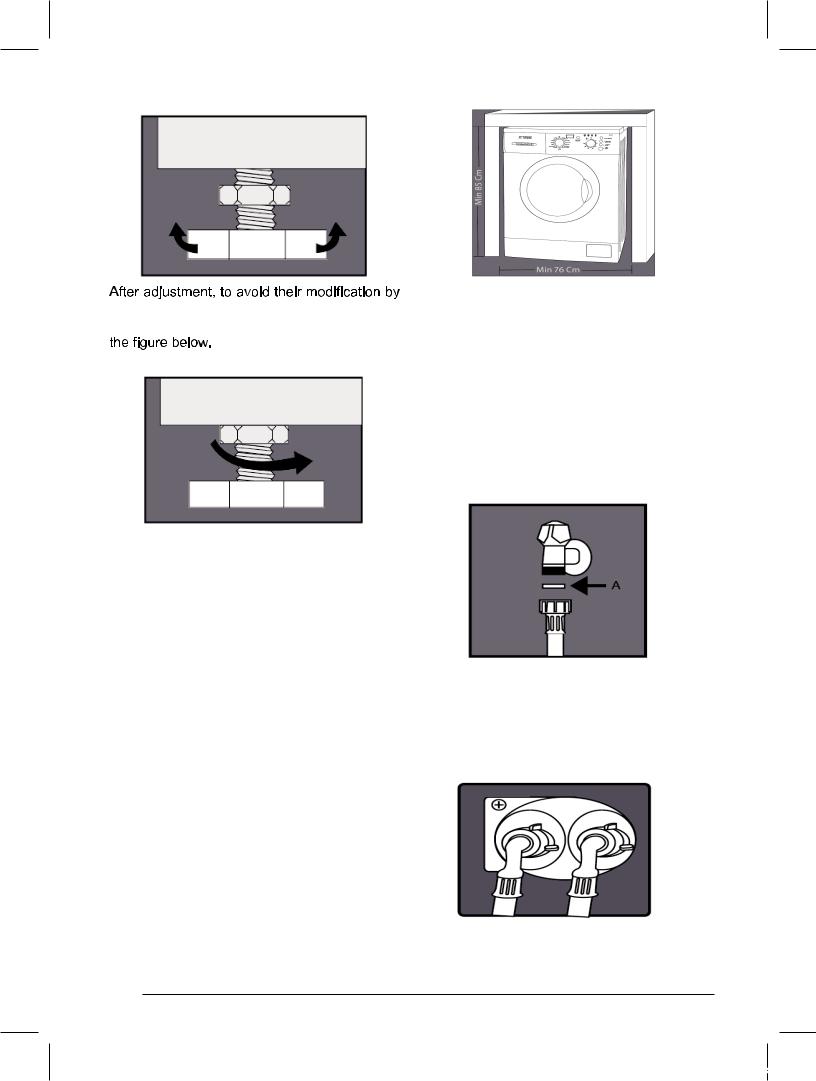
vibrations, they should tighten by the ring nut and/or nut on the foot until it locks as shown in
It is good to avoid, at any case, placing under or around to the machine cardboard, wood or similar materials, so as not to obstruct the passage of air.
INSTALLATION UNDER A WORK TOP
The positioning of the machine under a work top, can only happen if the housing compartment has the following dimensions of width of 76cm and of height of 85cm. It should also be considered that the machine needs a approximately 5cm behind from the wall. An example of a typical installation is shown in the illustration below. The superior cover (TOP) of the machine must not be removed for reasons of electrical and mechanical safety.
8
Figure 4
WATER SUPPLY CONNECTION
The water inlet hose must be connected to a tap of cold water with a 3/4” threaded mouth.
Use only the supplied water inlet hose, avoiding the use of old hoses, or hoses used previously.
N.B. the hose is already complete with rubber gasket, if this is missing, the tube must not be used.
If the water supply system is new or has been inactive for too long, it will be necessary to allow the water run until the water appears clear before connecting the hose.
Figure 5
DWD-M_DWD-FI.indd 8 |
2015-05-27 10:39:07 |
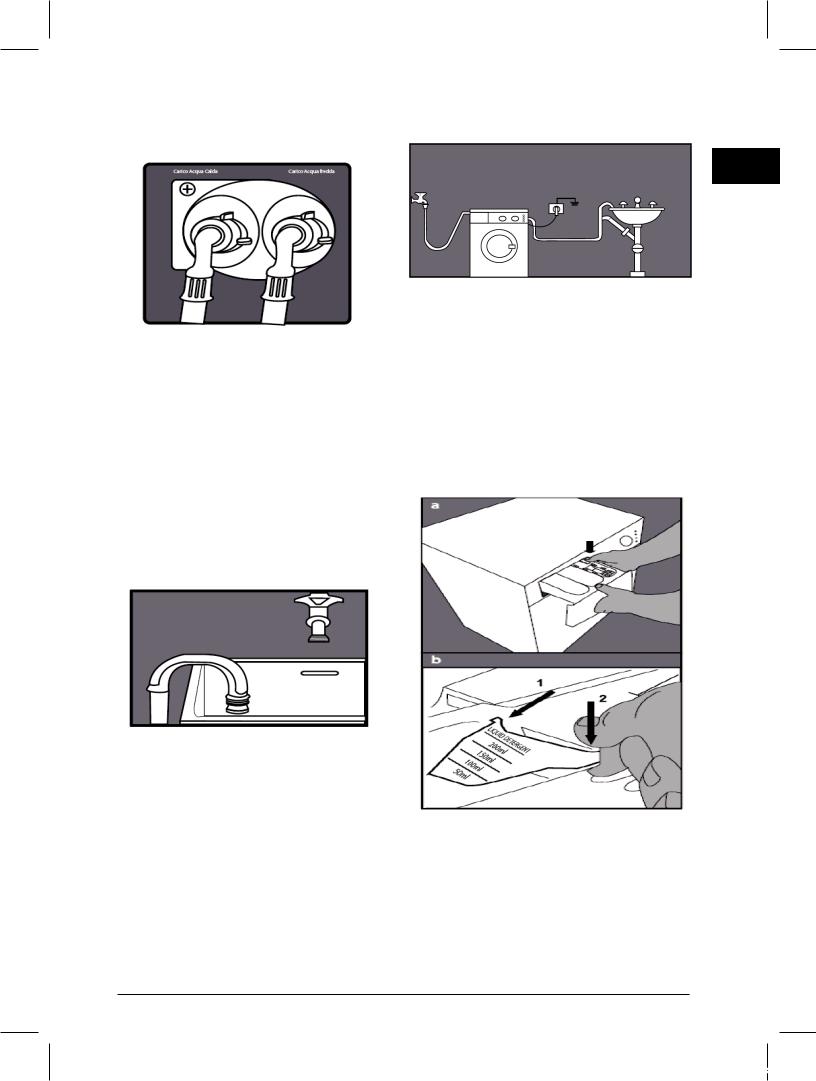
Figure 5b shows the connection to the hot water Example of installation tap, this option is only available on request.
Figure 7
Figure 5b
|
|
hot water |
cold water |
EN
N.B. It is not recommend using extension on the drain hose.
Make sure that the domestic hot water supply temperature does not exceed 55°C to avoid damage to the laundry and washing machine. For the inlet hose only use the supplied.
WATER DRAINAGE
Drain hose can be installed in two different ways:
- On the edge of sink using the plastic hose hanger commercially available.
Figure 6
In this case make sure that the tube is secured to the sink.
- In a drain pipe at a height of not less than 60 cm and not more than 90cm.
The tube end must always be ventilated, i.e. the inside diameter of the drain pipe must be larger than the outer diameter of the drain hose of the washing machine. The drain hose must not be obstructed.
LIQUID DETERGENT BULKHEAD PAN
Inside the kit supplied, there is a bulkhead pan of blue colour which grants the use of liquid detergents in the washing machine.
To install a bulkhead it is necessary to:
•remove the detergent drawer from the washing machine
•apply the bulkhead as shown in photo
After installation, replace the drawer into the washing machine. There is no need to remove the bulkhead (see p. 19).
POWER SUPPLY CONNECTION
The machine is equipped with a connecting cable and earthed plug for connection to
AC 230 V ~ 50 Hz.
9
DWD-M_DWD-FI.indd 9 |
2015-05-27 10:39:08 |

Make sure the plug is always accessible to unplug the machine from the mains.
The electrical power system must be designed according to VDE 0100.
It is recommend to not connect in any case the machine with extension cords multiple power sockets, etc to avoid overheating
To increase security VDE, in the directive DIN VDE 0100 in section 739, it is recommended to install a circuit breaker (RCD) with a tripping current of 30 mA (DIN VDE 0664).
If using a differential circuit breaker, make sure it is type A, according to DIN VDE 0664 and current sensitive buttons.
The rating plate provides information on rated current absorption and relating protection. Compare these data with the power supply.
IMPORTANT!
•AFTER HAVING INSTALLED THE APPLIANCE, THE POWER CORD MUST BE ACCESSIBLE
•IF THE POWER CORD IS DAMAGED, IT MUST BE SUBSTITUTED BY THE MANUFACTURE, ITS QUALIFIED TECHNICIAN WITH AIM OF AVOIDING DANGER
N.b. Do not use extension cords or adapters.
Figure 8
The manufacturer disclaims any liability for damage or injury caused by noncompliance with our safety rules
10
DWD-M_DWD-FI.indd 10 |
2015-05-27 10:39:08 |
